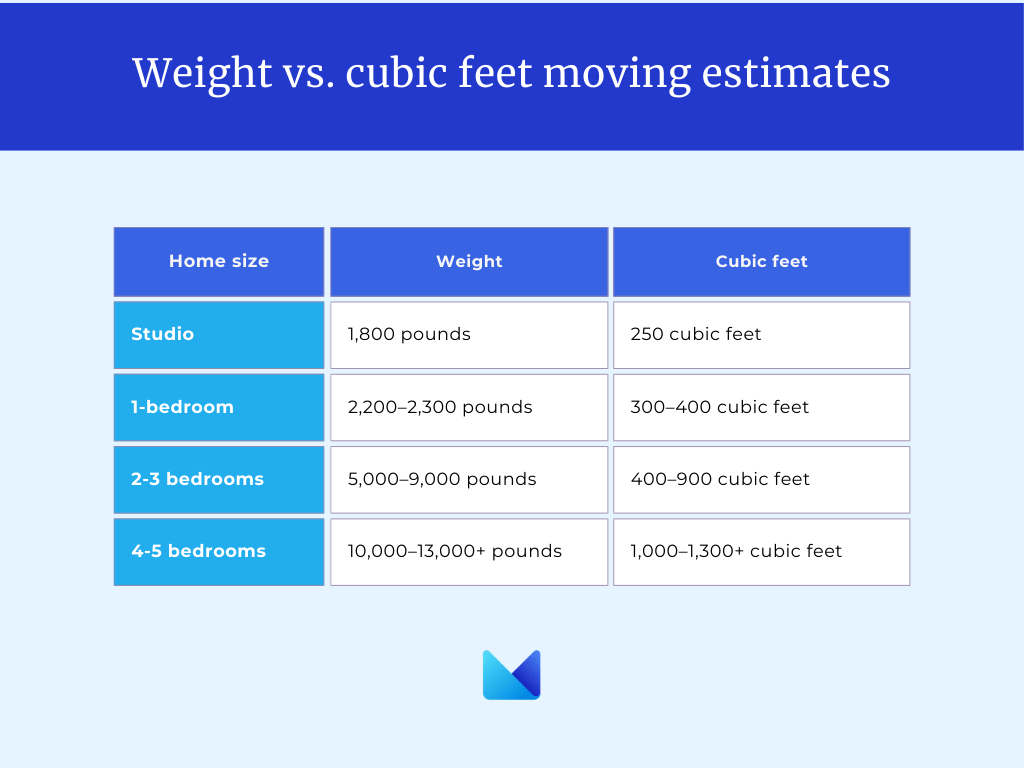Weight vs. Cubic Feet Moving Estimates
Quick answer: Weight-based estimates are determined by the total weight of your items, while cubic feet estimates are based on their total volume. In reality, it doesn’t matter which kind of estimate you’re given. Instead of getting hung up on the type of estimate, focus on finding a reputable mover.
If you want to avoid moving day surprises, it’s important to choose one of the top moving companies with a dependable reputation. Good long-distance movers usually provide a binding estimate after inventorying your home, so weight vs. volume doesn’t matter.
If you’re getting a binding estimate, pay closer attention to the items list (aka “Table of Measurements” or “Cube Sheet”). Your price is calculated using this list of household goods.
Still, it’s helpful to understand the two types of estimates. Read on to learn about the differences between weight and cubic feet so you can make an informed decision when you’re getting moving quotes.
Do movers charge by weight or volume?
Most moving companies charge by the weight of your belongings, not their volume. The U.S. Department of Transportation can verify weight-baed estimates easily, so they’re more reliable.
Most major van lines offer quotes based on the weight of your shipment, but the type of estimate a mover provides doesn’t matter as long as it’s a binding estimate.
A scammy moving company will find ways to overcharge you regardless of whether your estimate is weight-based or volume-based. Meanwhile, a good mover will ensure the move is properly quoted and make you aware of any scenarios where your moving estimate could increase.
Moving estimates by weight
While moving company weight estimates can vary, their key benefit is that they can be verified the U.S. Department of Transportation (USDOT). This is a very important distinction between weight- and volume-based estimates.
If you have a dispute with your mover, you can request the USDOT-certified weight tickets to verify everything.
The method for weighing all your stuff is surprisingly straightforward. Crews weigh the moving truck prior to loading and then again once everything is loaded. The difference between the two is the actual weight of your move.
Cubic feet estimates
Your move’s cost is determined by the total volume of your items—how much physical space they take up inside the moving truck. To determine the total volume of your items and how much space they’ll take up, movers multiply their length x width x height.
Unfortunately, common moving scams often involve cubic feet moving estimates. Packing the truck poorly or using generous measurements can increase the total cubic footage of a move. However, some of the best professional movers we work with use cubic footage.
These measurements are also helpful for portable moving container companies or moving truck rentals, giving you an idea of how much space you’ll need so you get the right number of containers or the right size moving truck.
Weight vs. cubic feet moving estimates: Industry standards
While your exact totals will vary, here are some rough estimates for different move sizes:
As a general rule, each full-size room in your house contains about 1,000–1,500 pounds of items. Most moving truck and shipping container companies list their capacities in terms of both maximum weight and cubic feet so you don’t risk overloading your truck or container.
Movers use industry-standard weights and measurement spreadsheets to help calculate the size of different items. This allows them to provide an accurate estimate of how many boxes you’ll need and the expected total weight or volume of your move.
In other words, the inventory list is what matters most, regardless of whether you’re getting a weight or cubic feet estimate.
Weight vs. cubic feet moving estimates: Which one is the best?
Bottom line—Hire reputable movers and you won’t need to worry about weight vs. cubic feet moving estimates.
Your binding estimate’s final price will be determined from an inventory list of the actual number of household goods you have. As long as that list is accurate, you won’t be responsible for extra charges if your items weigh a bit more than expected.
Get quotes from multiple movers, and make sure you’re working with a reliable moving company with a strong reputation.
Best movers for weight vs. cubic feet moving estimates
A mover’s reputation matters more than whether that company bases its estimates on weight or cubic feet.
Here are some of our top moving picks and the type of estimates that will matter most for each type of move.
Full-service movers
Full-service movers handle the loading, unloading, and transportation for your move. When you request a free quote, they’ll send a representative to your home or schedule a virtual walkthrough to inventory your items then make a weight- or cubic feet-based estimate.
Reputable full-service movers like American Van Lines and Mayzlin Relocation offer weight-based binding quotes based on your inventory and have reputations for stellar customer service.

|

|

|

|

|
|
|---|---|---|---|---|---|
| Price |
|
|
|
|
|
| Rating | |||||
| Minimum Shipping Size | 1+ bedrooms | 1+ bedrooms | 2+ bedrooms | 1+ bedrooms | 1+ bedrooms |
| Storage |
|
|
|
|
|
| Booking Deposit |
|
|
|
|
|
| Cancellation Policy | varies | 7 days prior to pickup | N/A | 7 days | varies |
| Quote |
| Quote | Price | Rating | Minimum Shipping Size | Storage | Booking Deposit | Cancellation Policy | |
|---|---|---|---|---|---|---|---|

|
|
1+ bedrooms |
|
|
varies | ||

|
|
1+ bedrooms |
|
|
7 days prior to pickup | ||

|
|
2+ bedrooms |
|
|
N/A | ||

|
|
1+ bedrooms |
|
|
7 days | ||

|
|
1+ bedrooms |
|
|
varies |
Moving container companies
Moving container companies are a good balance of full-service and DIY moves. While you’re responsible for packing, loading, and unloading, the company will transport the container from your old home to your new home, so you don’t have to worry about driving.
With a moving container company, it’s best to calculate the cubic feet of your items so you know what size container (or how many) you need. Some companies, like PODS, offer multiple container sizes. Others, such as U-Pack, let rent multiple containers based on your estimated needs.
| Company | Quote | Rating | Price |
|---|---|---|---|
U-Pack 
|
Check prices |
|
|
Zippy Shell 
|
Check prices |
|
|
Moving Place 
|
Check prices |
|
Rental trucks
Moving truck rentals are a good option for moving on a budget as long as you have the time and ability to pack, load, and transport everything on your own.
Quality truck rental companies like Budget Truck Rental and Penske Truck Rental are transparent about the weight limits and cubic footage capacity of their different truck sizes.
It’s easier to estimate the cubic feet of your items for a DIY move. Taking a rough estimate will help you figure out what size of moving truck you need to fit everything.
|
|
|
|
FAQ
Is it better to move by weight or cubic feet?
How do movers determine cubic feet?
How do I calculate my weight for moving?
What is the average weight of a one-bedroom move?
How much does an average move weigh?
What happens if your moving inventory is inaccurate?
Not what you were looking for?
Check out other categories that can help you find the information you need!






